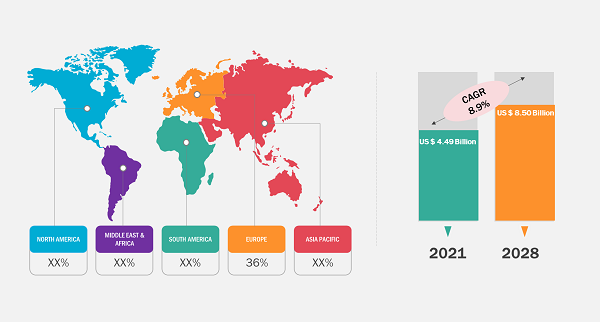Rise in Demand for Packaged and Convenience Food Drives Shelf-Life Testing Market
According to our latest study on "Shelf-Life Testing Market Forecast to 2028 – COVID-19 Impact and Global Analysis – by Parameter, Food Tested, Method, and Technology," the market is expected to grow from US$ 4.49 billion in 2021 to US$ 8.50 billion by 2028; it is estimated to grow at a CAGR of 8.9% from 2022 to 2028.

Shelf-Life Testing Market Scope, Size, and Share by 2031
Download Free SampleShelf-Life Testing Market Size and Forecasts (2021 - 2031), Global and Regional Share, Trends, and Growth Opportunity Analysis Report Coverage: by Parameter (Microbial Contamination, Rancidity, Nutrient Stability, Organoleptic Properties, and Others), Food Tested (Packaged Food, Beverages, Bakery and Confectionery Products, Meat and Meat Products, Dairy and Dairy Products, Desserts, Processed Fruits and Vegetables, and Others), Method (Real-Time Shelf Life Testing and Accelerated Shelf-Life Testing), Technology (Equipment and Kit-Based and Manual Tests), and Geography (North America, Europe, Asia Pacific, and South and Central America)
Source: The Insight Partners Analysis
Shelf-life testing is done to determine the expected shelf-life of a food product and when it should be safe for consumption. It lowers the likelihood of product recalls; identifies the causes of decreased shelf life; and helps improve products, processes, and profitability. The introduction of stringent safety regulations for food products and an increase in the outbreak of foodborne illnesses propel the growth of the shelf-life testing market. Moreover, the surge in demand for packaged and convenience food products is also contributing to the market growth.
The food processing industry has been profoundly growing over the past decade, as consumers are demanding ready-to-eat, easy-to-cook, and convenient packaged food products. The rising demand for such products boosts the shelf-life testing market growth. Moreover, the growing disposable income of consumers, rising number of working women, and surging dual working households indirectly contribute to the market growth. Furthermore, the rising number of deaths due to eating contaminated food, the increasing incidence of foodborne illnesses, and food poisoning accelerate the market growth.
Additionally, the rising level of intricacies and the increasing number of supply chain participants have made it difficult for manufacturers to uniformly adopt hygienic and sanitized manufacturing practices. Such factors have led to an increase in the incidence of food contamination, thereby compelling various governments across the world to develop and implement stringent food safety regulations. Many regulatory bodies, including the United States Department of Agriculture (USDA) and European Food Safety Authority (EFSA), are introducing guidelines for the safety and quality assurance of food products. Similar guidelines are adopted by other countries, worldwide, with variations and exceptions in laws. This factor is strengthening the shelf-life testing market.
The adoption of newer technologies in the shelf-life testing procedures bolsters the market growth. Technological developments are rising in the spectrometry segment. The implementation of advanced technologies in a laboratory offers higher sensitivity, accuracy in results, reliability, multi-contaminant and non-targeted screening with a low turnaround time, and cost-effectiveness. Therefore, high adoption of these technologies, with financial support from government authorities, is an opportunity for medium- and small-scale laboratories to expand their service offerings and compete with prominent market players in the industry. This factor is proliferating the market growth. Moreover, many partnerships, mergers, and acquisitions have contributed to the market growth. For instance, in April 2018, Eurofins signed an agreement with LabCorp to acquire its food testing and consulting business, Covance Food Solutions, for US$ 670 million. Covance Food Solutions operates an integrated network of 12 facilities across the world with 9 in the US, 2 in the UK, and 1 in Asia. Thus, the acquisition helped Eurofins expand its presence in North America, the UK, and Asia.
TÜV SÜD, Mérieux, AsureQuality, RJ Hill Laboratories, Intertek Group plc, SCS Global, Agrifood Technology, Symbio Laboratories, Microchem Lab Services, and Premier Analytical Services are among the key shelf-life testing market players profiled during the study. Several other major companies were studied and analyzed during this research study to get a holistic view of the shelf-life testing market and its ecosystem.
Contact Us
Phone: +1-646-491-9876
Email Id: sales@theinsightpartners.com